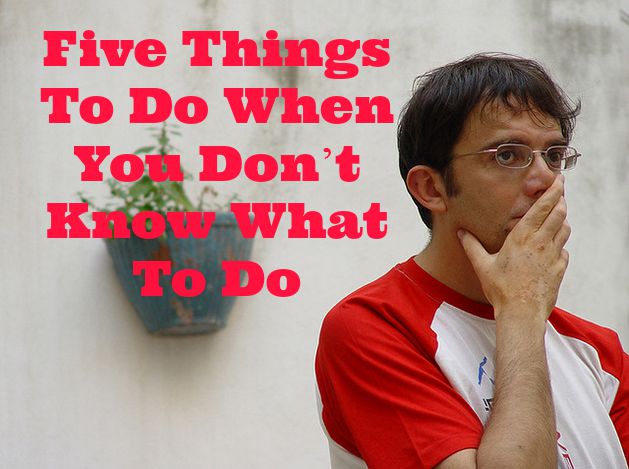
Sometimes you just don’t know what to do.
You’re a grown-up. So, you’re always supposed to know what to do, right? Unfortunately, that’s not always the case. Look at the following situations:

- You have a problem at work, and you don’t know what to do.
- Everything is going as it should. Then, something unexpected happens that derails your plans, and you don’t know what to do to get your plans back on track.
- Your business is not doing as well as you had hoped, and you don’t know what to do.
- There’s a goal that you would like to pursue, but you keep procrastinating on getting started because you don’t know what to do.
First, accept that it’s OK not to know everything. Then, look for a way to get back in the game. Below you’ll find five things to do when you don’t know what to do.
1. Get More Information. Whatever problem you may be having at this moment, you can rest assured that someone else has already had that problem. And they’ve solved it. In addition, they’ve written a book or an article about the problem and what they did to solve it, or they’ve created a YouTube video explaining what they did.
Look for that information and use it to plan your next step.
2. Find a Mentor. One of my favorite TV shows of all time is “The West Wing”. It’s fast, it’s entertaining, and I learn something new every time I watch an episode of the show, no matter how many times I’ve seen it before. In one episode, Leo—the Chief of Staff—tells the following story to his assistant, who’s going through a hard time:
“This guy’s walking down the street when he falls in a hole. The walls are so steep he can’t get out.
“A doctor passes by and the guy shouts up, ‘Hey you. Can you help me out?’ The doctor writes a prescription, throws it down in the hole and moves on.
“Then a priest comes along and the guy shouts up, ‘Father, I’m down in this hole. Can you help me out?’ The priest writes out a prayer, throws it down in the hole and moves on.
“Then a friend walks by, ‘Hey, Joe, it’s me can you help me out?’ And the friend jumps in the hole. Our guy says, ‘Are you stupid? Now we’re both down here.’ The friend says, ‘Yeah, but I’ve been down here before and I know the way out.'”
When you’re facing a problem and you don’t know what to do, find a friend or acquaintance who has already been in the hole you’re currently in. Then, ask them for help getting out, or for some advice or ideas on what to do.
3. Act, Learn, Build, Repeat. The Harvard Business Review has an article in which they lay out the process that you should follow when you don’t know what to do. The process they recommend is the following:
- Take a smart step as quickly as you can. A smart step is one which you can take quickly with whatever means you already have at your disposal. Make sure that the step you’re thinking of taking could not result in a loss that’s greater than what would be acceptable.
- Reflect on the results that you get once you take the smart step. Every time you act you get some sort of information or feedback in return. Are you now closer to your goal? Did taking the step reveal that there’s something else that you need to do? What did you learn from the action that you took? Build on the results that you got by acting.
- Repeat until you solve the problem or achieve the goal. Act, learn, build, and repeat until you achieve the results that you’re after.
4. Do The Obvious. The other day I came across a booklet called “Obvious Adams: The Story of A Successful Businessman”. It was first published as a short story in the Saturday Evening Post in April, 1916. The story was an immediate hit and soon became a business classic.
Oliver B. Adams was an ordinary man. He was not particularly bright, good looking, or charismatic. However, he was in advertising—which is a very competitive field—and he managed to rise to the very top of the world of advertising. He did this by having a knack for the obvious.
Here’s what the author of the booklet, Robert R. Updegraff, once said about doing the obvious:
“The trouble is, the obvious is apt to be so simple and commonplace that it has no appeal to the imagination. We all like clever ideas and ingenious plans that make good lunch-table talk at the club. There is something about the obvious that is–well, so very obvious!”
Adams succeeded because at every step of his life, he did the obvious thing. That is, he did the thing which most people miss because it’s so simple. Instead of coming up with long, drawn out, complex plans, he would look for the most common sense approach to solving the problem before him.
The next time you don’t know what to do, follow Obvious Adams’ lead. Ask yourself, “What’s the obvious solution or the obvious next step?” Then, do the obvious. (You can read “Obvious Adams”, for free, here.)
5. Find a Bright Spot. In their book, Switch: How to Change Things When Change Is Hard, brothers Chip and Dan Heath explain that one approach to solving problems is to look for bright spots. That is, find out what’s working and do more of it.
For example, suppose that your child comes home with their report card. The good news is, he got an A+ in English. The bad news is, he’s barely passing science. At that point, if you’re going to follow the bright spot approach, you would do the following:
- Ask your child what he’s doing in order to get such good grades in English.
- Then, brainstorm ways in which he could apply those same strategies to studying for science.
When you’re facing a situation in which you don’t know what to do, think of problems that you’ve solved in the past, or think of goals that you’ve been successful in achieving. Ask yourself the following questions:
- How did you solve those problems?
- What strategies did you use?
- What did you do to achieve those goals?
- How can you apply what you’ve done in the past to achieve your goals or solve problems, to the problem that you’re facing in the present?
Figure out what to do, when you don’t know that to do, by thinking of the bright spots in your life and looking for ways to clone or replicate them.
Conclusion
Stop allowing the phrase “I don’t know what to do” to paralyze you. Instead, do one of the five things explained above. Live your best life by having a strategy for those times when you don’t know what to do.





Related Posts:




 Marelisa Fabrega is a lawyer and entrepreneur. She holds a Bachelor of Science in Business Administration from Georgetown University in Washington, D.C., as well as a Juris Doctor from the Georgetown University Law Center. You can learn more about her
Marelisa Fabrega is a lawyer and entrepreneur. She holds a Bachelor of Science in Business Administration from Georgetown University in Washington, D.C., as well as a Juris Doctor from the Georgetown University Law Center. You can learn more about her 





